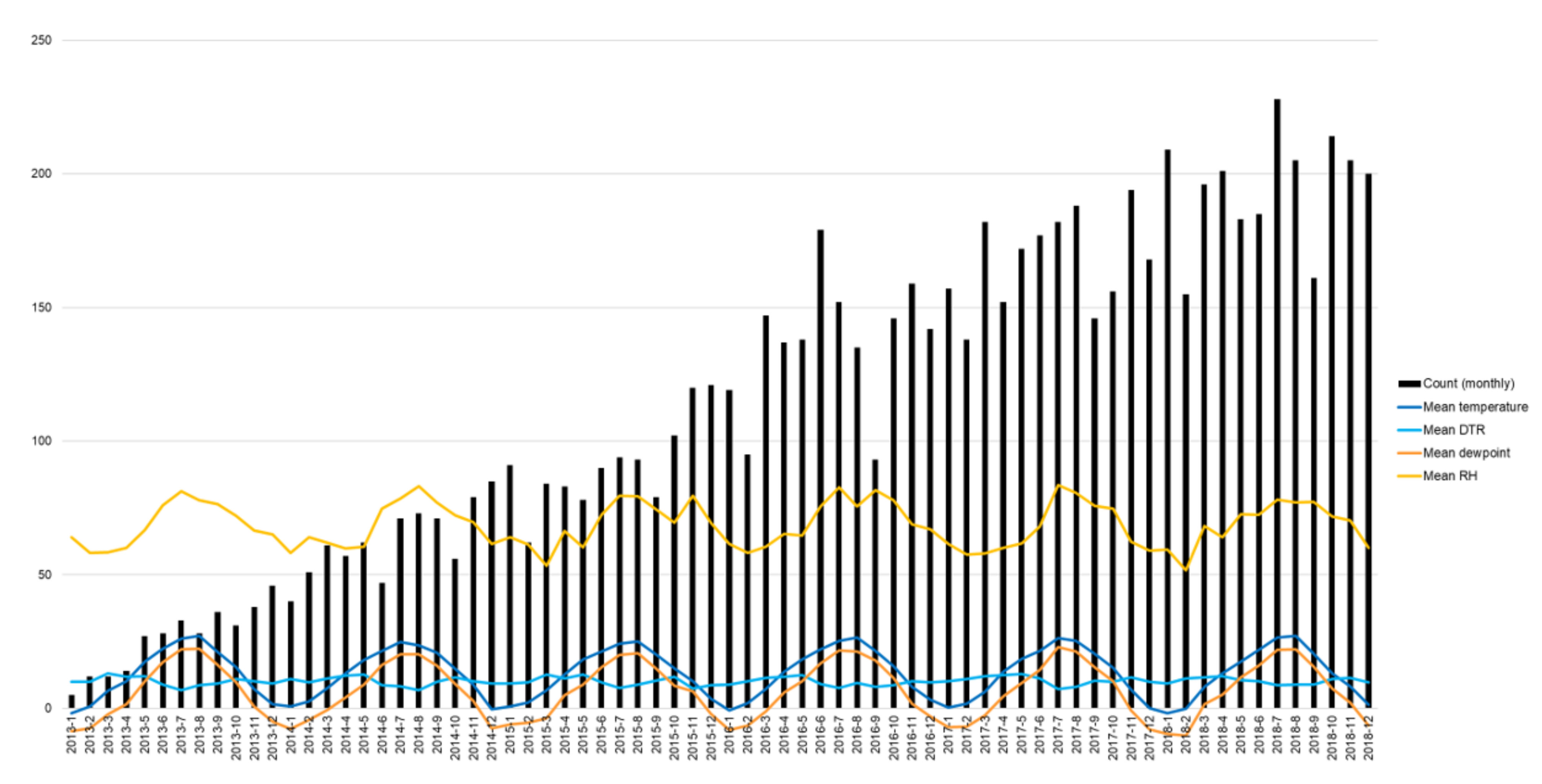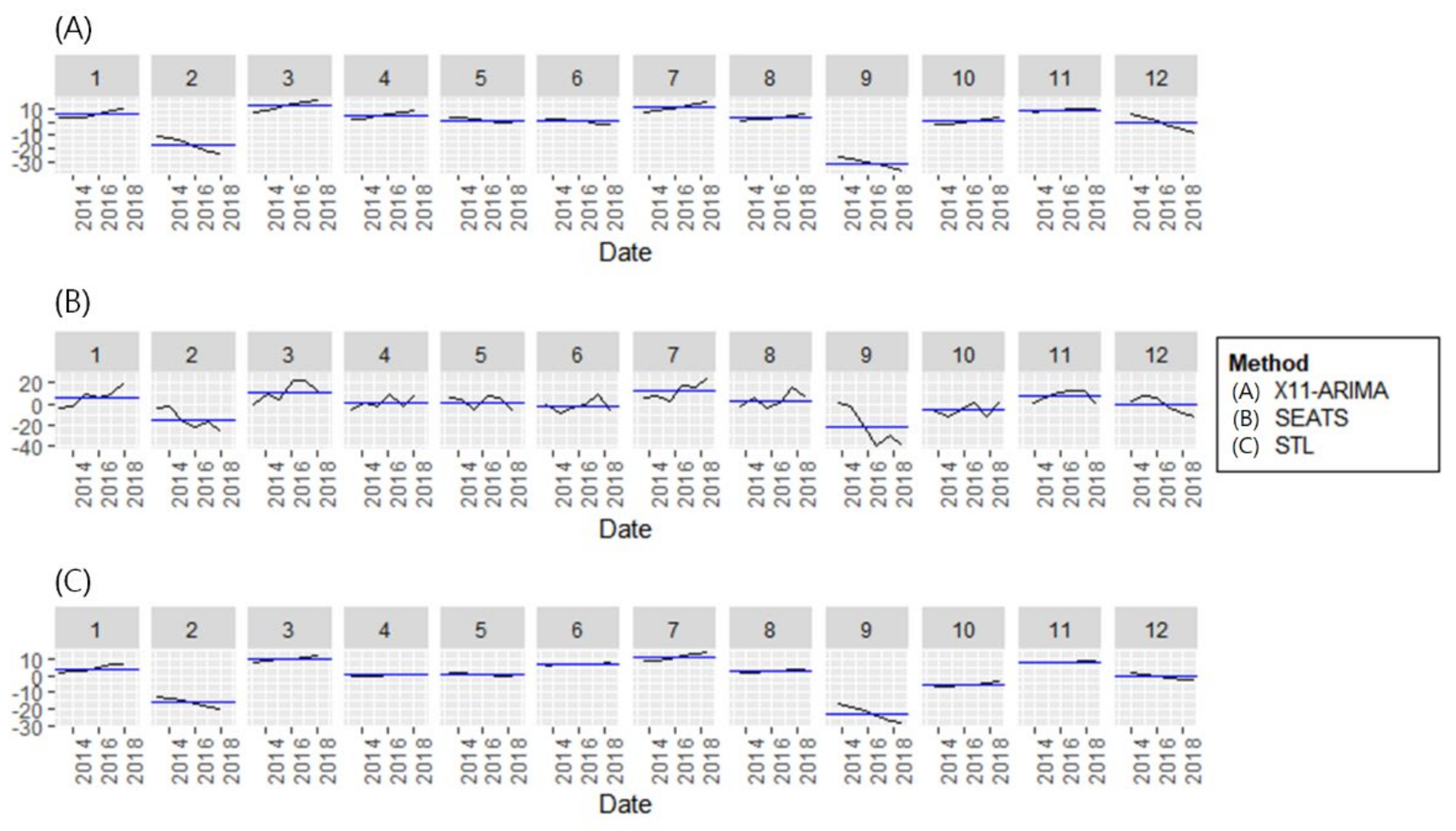Trend and Seasonality of Diabetic Foot Amputation in South Korea: A Population-Based Nationwide Study
Abstract
1. Introduction
2. Materials and Methods
2.1. Study Population and Definition of Diabetic Foot Amputation
2.2. Climate Information during the Research Period
2.3. Statistical Analysis
3. Results
3.1. Overall and Monthly Trends in Diabetic Foot Amputation
3.2. Comparison between Diabetic Foot Amputation Trend and Climate Information
4. Discussion
5. Conclusions
Supplementary Materials
Author Contributions
Funding
Institutional Review Board Statement
Informed Consent Statement
Data Availability Statement
Conflicts of Interest
References
- Quan, J.; Li, T.; Pang, H.; Choi, C.; Siu, S.; Tang, S.; Wat, N.; Woo, J.; Johnston, J.; Leung, G. Diabetes incidence and prevalence in Hong Kong, China during 2006–2014. Diabet. Med. 2017, 34, 902–908. [Google Scholar] [CrossRef] [PubMed]
- Boulton, A.J.; Vileikyte, L.; Ragnarson-Tennvall, G.; Apelqvist, J. The global burden of diabetic foot disease. Lancet 2005, 366, 1719–1724. [Google Scholar] [CrossRef]
- Federation, I.D. IDF Diabetes Atlas, 9th ed.; International Diabetes Federation: Brussels, Belgium, 2019. [Google Scholar]
- Narres, M.; Kvitkina, T.; Claessen, H.; Droste, S.; Schuster, B.; Morbach, S.; Rümenapf, G.; Van Acker, K.; Icks, A. Incidence of lower extremity amputations in the diabetic compared with the non-diabetic population: A systematic review. PLoS ONE 2017, 12, e0182081. [Google Scholar] [CrossRef] [PubMed]
- Harding, J.L.; Pavkov, M.E.; Magliano, D.J.; Shaw, J.E.; Gregg, E.W. Global trends in diabetes complications: A review of current evidence. Diabetologia 2019, 62, 3–16. [Google Scholar] [CrossRef] [PubMed]
- Jeffcoate, W.; Van Houtum, W. Amputation as a marker of the quality of foot care in diabetes. Diabetologia 2004, 47, 2051–2058. [Google Scholar] [CrossRef] [PubMed][Green Version]
- Chun, D.-I.; Kim, S.; Kim, J.; Yang, H.-J.; Kim, J.H.; Cho, J.-H.; Yi, Y.; Kim, W.J.; Won, S.H. Epidemiology and burden of diabetic foot ulcer and peripheral arterial disease in Korea. J. Clin. Med. 2019, 8, 748. [Google Scholar] [CrossRef] [PubMed]
- Quattrini, C.; Jeziorska, M.; Malik, R. Small fiber neuropathy in diabetes: Clinical consequence and assessment. Int. J. Low. Extrem. Wounds 2004, 3, 16–21. [Google Scholar] [CrossRef] [PubMed]
- Yavuz, M.; Ersen, A.; Hartos, J.; Lavery, L.A.; Wukich, D.K.; Hirschman, G.B.; Armstrong, D.G.; Quiben, M.U.; Adams, L.S. Temperature as a causative factor in diabetic foot ulcers: A call to revisit ulceration pathomechanics. J. Am. Podiatr. Med. Assoc. 2019, 109, 345–350. [Google Scholar] [CrossRef] [PubMed]
- Armstrong, D.G.; Lavery, L.A.; Van Houtum, W.H.; Harkless, L.B. Seasonal variations in lower extremity amputation. J. Foot Ankle Surg. 1997, 36, 146–150. [Google Scholar] [CrossRef]
- Leung, H.; Ho, Y.; Wong, W.; Guerin, J. Seasonal variations in non-traumatic major lower limb amputation in Hong Kong Chinese diabetic patients. Hong Kong Med. J. 2007, 13, 379. [Google Scholar] [PubMed]
- Gaspar da Rocha, A.; Almendra, R.; Melo, M.; Santana, P. Seasonal pattern of amputations in diabetic patients between 2000 and 2015 in Portugal. Eur. J. Public Health 2018, 28, cky214.156. [Google Scholar] [CrossRef]
- Won, S.H.; Chung, H.-J.; Lee, J.; Jeon, Y.J.; Chun, D.-I.; Min, T.-H.; Cho, J.; Won, S.; Yi, Y. Diurnal Temperature Ranges in Relation to Lower Limb Amputation Rate of Diabetic Foot in South Korea: A Population Based Nationwide Study. Int. J. Environ. Res. Public Health 2021, 18, 9191. [Google Scholar] [CrossRef] [PubMed]
- Kim, J.; Chun, D.-i.; Kim, S.; Yang, H.-J.; Kim, J.H.; Cho, J.-h.; Yi, Y.; Kim, W.J.; Won, S.H. Trends in lower limb amputation in patients with diabetic foot based on vascular intervention of peripheral arterial disease in Korea: A population-based nationwide study. J. Korean Med. Sci. 2019, 34, e178. [Google Scholar] [CrossRef] [PubMed]
- Bae, J.-I.; Won, J.H.; Kim, J.S.; Kim, M.D.; Yoon, C.J.; Cho, Y.K. Prevalence and current status of treatment of diabetic foot in South Korea. J. Korean Soc. Radiol. 2016, 74, 169–176. [Google Scholar] [CrossRef][Green Version]
- Sax, C.; Eddelbuettel, D.; Sax, M.C. Package ‘Seasonal’. Available online: https://cran.r-project.org/web/packages/seasonal/seasonal.pdf (accessed on 18 September 2021).
- Maravall, A. A class of diagnostics in the ARIMA-model-based decomposition of a time series. In Seasonal Adjustment; European Central Bank: Frankfurt, Germany, 2003; pp. 23–36. [Google Scholar]
- Ryan, J.A.; Ulrich, J.M. xts: Extensible time series. In R Package Version 0.8-2. Available online: https://cran.r-project.org/web/packages/xts/vignettes/xts.pdf (accessed on 18 May 2008).
- Hyndman, R.J.; Khandakar, Y. Automatic time series forecasting: The forecast package for R. J. Stat. Softw. 2008, 27, 1–22. [Google Scholar] [CrossRef]
- Dagum, E.B. Modelling, forecasting and seasonally adjusting economic time series with the X-11 ARIMA method. J. R. Stat. Society Ser. D 1978, 27, 203–216. [Google Scholar] [CrossRef]
- Hyndman, R.J.; Athanasopoulos, G. Forecasting: Principles and Practice; OTexts: Melbourne, Australia, 2018. [Google Scholar]
- Cleveland, R.B.; Cleveland, W.S.; McRae, J.E.; Terpenning, I. STL: A seasonal-trend decomposition. J. Off. Stat 1990, 6, 3–73. [Google Scholar]



| Year-Month | Monthly Frequency | Mean Temperature | Mean DTR | Mean DPT | Mean RH |
|---|---|---|---|---|---|
| 2013-1 | 5 | −1.79 | 9.88 | −8.43 | 64.03 |
| 2013-2 | 12 | 0.81 | 9.85 | −7.56 | 58.13 |
| 2013-3 | 12 | 6.58 | 13.05 | −2.29 | 58.45 |
| 2013-4 | 14 | 10.19 | 11.80 | 1.45 | 60.04 |
| 2013-5 | 27 | 17.59 | 11.96 | 10.16 | 66.71 |
| 2013-6 | 28 | 22.27 | 8.94 | 17.27 | 75.99 |
| 2013-7 | 33 | 26.03 | 6.81 | 22.20 | 81.17 |
| 2013-8 | 28 | 27.04 | 8.77 | 22.35 | 77.80 |
| 2013-9 | 36 | 21.03 | 9.34 | 16.17 | 76.48 |
| 2013-10 | 31 | 15.41 | 11.08 | 9.67 | 71.91 |
| 2013-11 | 38 | 7.17 | 10.17 | 0.61 | 66.53 |
| 2013-12 | 46 | 1.61 | 9.25 | −4.87 | 65.02 |
| 2014-1 | 40 | 0.64 | 10.96 | −7.66 | 58.11 |
| 2014-2 | 51 | 2.55 | 9.82 | −4.33 | 64.05 |
| 2014-3 | 61 | 7.59 | 11.19 | −0.45 | 62.00 |
| 2014-4 | 57 | 13.16 | 12.14 | 4.09 | 59.91 |
| 2014-5 | 62 | 18.12 | 12.73 | 8.93 | 60.42 |
| 2014-6 | 47 | 21.51 | 8.75 | 16.26 | 74.66 |
| 2014-7 | 71 | 24.75 | 8.19 | 20.29 | 78.57 |
| 2014-8 | 73 | 23.59 | 6.76 | 20.20 | 83.07 |
| 2014-9 | 71 | 20.75 | 9.84 | 16.01 | 76.97 |
| 2014-10 | 56 | 14.83 | 11.54 | 9.09 | 72.30 |
| 2014-11 | 79 | 8.91 | 10.25 | 2.86 | 69.73 |
| 2014-12 | 85 | −0.25 | 9.25 | −7.47 | 61.56 |
| 2015-1 | 91 | 0.72 | 9.37 | −6.05 | 64.06 |
| 2015-2 | 62 | 2.12 | 9.67 | −5.37 | 61.39 |
| 2015-3 | 84 | 6.72 | 12.72 | −3.79 | 53.27 |
| 2015-4 | 83 | 12.56 | 11.16 | 5.01 | 66.35 |
| 2015-5 | 78 | 18.33 | 12.69 | 8.95 | 60.28 |
| 2015-6 | 90 | 21.33 | 9.77 | 15.29 | 72.37 |
| 2015-7 | 94 | 24.11 | 7.69 | 19.94 | 79.66 |
| 2015-8 | 93 | 24.99 | 8.80 | 20.71 | 79.41 |
| 2015-9 | 79 | 20.27 | 10.41 | 14.93 | 74.55 |
| 2015-10 | 102 | 14.94 | 11.84 | 8.51 | 69.42 |
| 2015-11 | 120 | 10.18 | 7.48 | 6.37 | 79.53 |
| 2015-12 | 121 | 3.71 | 8.73 | −2.00 | 69.46 |
| 2016-1 | 119 | −0.69 | 8.80 | −8.04 | 61.48 |
| 2016-2 | 95 | 1.87 | 10.07 | −6.40 | 58.26 |
| 2016-3 | 147 | 7.17 | 11.51 | −1.19 | 60.45 |
| 2016-4 | 137 | 13.66 | 11.85 | 5.86 | 65.30 |
| 2016-5 | 138 | 18.33 | 12.47 | 10.16 | 64.58 |
| 2016-6 | 179 | 22.02 | 9.01 | 16.83 | 75.63 |
| 2016-7 | 152 | 25.21 | 7.66 | 21.69 | 82.70 |
| 2016-8 | 135 | 26.45 | 9.52 | 21.22 | 75.53 |
| 2016-9 | 93 | 21.48 | 8.02 | 17.81 | 81.66 |
| 2016-10 | 146 | 15.80 | 8.68 | 11.46 | 77.84 |
| 2016-11 | 159 | 7.97 | 10.18 | 1.85 | 68.77 |
| 2016-12 | 142 | 3.25 | 9.82 | −3.02 | 66.91 |
| 2017-1 | 157 | 0.27 | 10.13 | −7.05 | 61.54 |
| 2017-2 | 138 | 1.74 | 11.04 | −6.74 | 57.58 |
| 2017-3 | 182 | 6.22 | 11.95 | −2.75 | 57.93 |
| 2017-4 | 152 | 13.67 | 12.45 | 4.46 | 60.14 |
| 2017-5 | 172 | 18.46 | 12.83 | 9.60 | 61.79 |
| 2017-6 | 177 | 21.52 | 11.16 | 14.33 | 68.03 |
| 2017-7 | 182 | 26.24 | 7.30 | 22.88 | 83.61 |
| 2017-8 | 188 | 25.32 | 8.08 | 21.28 | 80.60 |
| 2017-9 | 146 | 20.47 | 10.40 | 15.40 | 75.75 |
| 2017-10 | 156 | 15.26 | 9.99 | 10.18 | 74.83 |
| 2017-11 | 194 | 6.91 | 11.62 | −0.73 | 62.38 |
| 2017-12 | 168 | 0.01 | 9.86 | −7.95 | 59.01 |
| 2018-1 | 209 | −1.87 | 9.29 | −9.63 | 59.40 |
| 2018-2 | 155 | −0.08 | 11.22 | −10.12 | 51.67 |
| 2018-3 | 196 | 8.03 | 11.69 | 1.58 | 68.30 |
| 2018-4 | 201 | 13.14 | 12.11 | 5.05 | 64.13 |
| 2018-5 | 183 | 17.59 | 10.62 | 11.67 | 72.54 |
| 2018-6 | 185 | 21.92 | 10.09 | 15.96 | 72.44 |
| 2018-7 | 228 | 26.54 | 8.71 | 21.90 | 78.06 |
| 2018-8 | 205 | 27.04 | 8.79 | 22.10 | 76.95 |
| 2018-9 | 161 | 20.33 | 8.93 | 15.68 | 77.19 |
| 2018-10 | 214 | 13.05 | 11.08 | 7.35 | 71.79 |
| 2018-11 | 205 | 8.17 | 11.31 | 2.20 | 70.25 |
| 2018-12 | 200 | 1.40 | 9.64 | −6.50 | 60.00 |
Publisher’s Note: MDPI stays neutral with regard to jurisdictional claims in published maps and institutional affiliations. |
© 2022 by the authors. Licensee MDPI, Basel, Switzerland. This article is an open access article distributed under the terms and conditions of the Creative Commons Attribution (CC BY) license (https://creativecommons.org/licenses/by/4.0/).
Share and Cite
Chung, H.-J.; Chun, D.-I.; Kang, E.M.; Kim, K.; Lee, J.; Jeon, Y.J.; Cho, J.; Won, S.; Yi, Y. Trend and Seasonality of Diabetic Foot Amputation in South Korea: A Population-Based Nationwide Study. Int. J. Environ. Res. Public Health 2022, 19, 4111. https://doi.org/10.3390/ijerph19074111
Chung H-J, Chun D-I, Kang EM, Kim K, Lee J, Jeon YJ, Cho J, Won S, Yi Y. Trend and Seasonality of Diabetic Foot Amputation in South Korea: A Population-Based Nationwide Study. International Journal of Environmental Research and Public Health. 2022; 19(7):4111. https://doi.org/10.3390/ijerph19074111
Chicago/Turabian StyleChung, Hyung-Jin, Dong-Il Chun, Eun Myeong Kang, Keonwoo Kim, Jinyoung Lee, Ye Jin Jeon, Jaeho Cho, Sungho Won, and Young Yi. 2022. "Trend and Seasonality of Diabetic Foot Amputation in South Korea: A Population-Based Nationwide Study" International Journal of Environmental Research and Public Health 19, no. 7: 4111. https://doi.org/10.3390/ijerph19074111
APA StyleChung, H.-J., Chun, D.-I., Kang, E. M., Kim, K., Lee, J., Jeon, Y. J., Cho, J., Won, S., & Yi, Y. (2022). Trend and Seasonality of Diabetic Foot Amputation in South Korea: A Population-Based Nationwide Study. International Journal of Environmental Research and Public Health, 19(7), 4111. https://doi.org/10.3390/ijerph19074111







